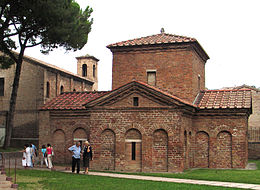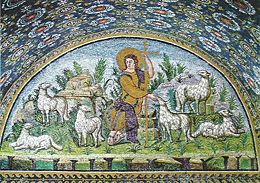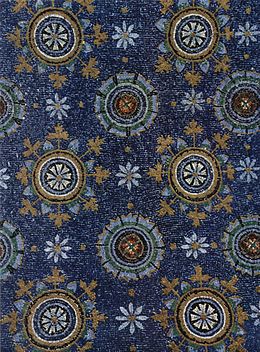- Mausoleum of Galla Placidia
-
The Mausoleum of Galla Placidia is a Roman building in Ravenna, Italy. It was listed with seven other structures in Ravenna in the World Heritage List in 1996. The UNESCO experts describe it as "the earliest and best preserved of all mosaic monuments, and at the same time one of the most artistically perfect".
The mausoleum is laid out in a Greek cross plan with a central dome on pendentives and barrel vaults over the four transepts. The exterior of the dome is enclosed in a square tower that rises above the gabled lateral wings. The brick surface is set with narrow mortar joints and decorated with blind arcades.
The building was formerly the oratory of the Church of the Holy Cross and now contains three sarcophagi. The largest was thought to contain the remains of Galla Placidia (died 450), daughter of the Roman Emperor Theodosius I. Her embalmed body was reportedly deposited there in a sitting position, clothed with the imperial mantle. In 1577, however, the contents of the sarcophagus were accidentally burned. The sarcophagus to the right is attributed to Galla's son, Emperor Valentinian III, or to her brother, Emperor Honorius. The one on the left is attributed to her husband, Emperor Constantius III.
The building is not currently used as a mausoleum. It is unknown what the building was intended for when it was built. The most common story is that the structure was built by Galla Placidia, who was a well-known patron of the arts, to be used as a mausoleum for her and her family. There seems to be no evidence to prove or disprove Galla’s connection to the building. The mausoleum was once connected to the narthex of Santa Croce, the church for the imperial palace, built in 417 but now in ruins. Santa Croce was one of the first buildings commissioned by Galla. The floor has been raised by five feet since the fifth century in order to remain above the rising water along the upper Adriatic coast.
The interior of the mausoleum is covered with rich Byzantine mosaics, and light enters through alabaster window panels. The inside contains two famous mosaic lunettes, and the rest of the interior is filled with mosaics of Christian and Apocalyptic symbols. The central bay's upper walls are decorated with four pairs of apostles, including St. Peter and St. Paul, acclaiming a giant gold cross in the center of the dome against a blue sky of stars. Symbols of the four evangelists float among the clouds. The other four apostles appear in the barrel vaults of the transepts.
The lunette over the north entrance shows a mosaic of Christ as the Good Shepherd tending his flocks. He holds an imperial staff joined to the Christian cross, symbolizing the combined earthly and heavenly domains. The lunette over the south wall is thought to depict St. Lawrence standing next to a flaming gridiron. On the opposite side of the gridiron a bookcase is shown with four books, each inscribed with the name of an evangelist.
The art historian Gillian Mackie argues that this panel represents the Spanish St. Vincent of Saragossa rather than the Italian St. Lawrence.[1] Mackie cites Galla's connection to Spain; in addition, St. Vincent was martyred by drowning at sea, and Galla and her children had been delivered from shipwreck. The panel seems to be an illustration of the poem about St. Vincent in Prudentius's fifth century Passio Sancti Vincent Martyris. In the poem St. Vincent is ordered to disclose his sacred books to be burned. This explains the cupboard containing the Gospels, which has no satisfactory explanation in the story of St. Lawrence.
Contents
Musical associations
The mausoleum is reputed to have inspired American songwriter Cole Porter to compose "Night and Day" while on a 1920s visit.[2]
See also
References
External links
 Media related to Mausoleum of Galla Placidia at Wikimedia Commons
Media related to Mausoleum of Galla Placidia at Wikimedia Commons- Galla Placidia Mausoleum
Coordinates: 44°25′16″N 12°11′49″E / 44.42111°N 12.19694°E
Categories:- 5th-century architecture
- Mausoleums in Italy
- Cemetery art
- Palaeo-Christian architecture in Ravenna
- Byzantine sacred architecture
- Christian sites of the Roman Empire
- Christian organizations established in the 5th century
Wikimedia Foundation. 2010.




